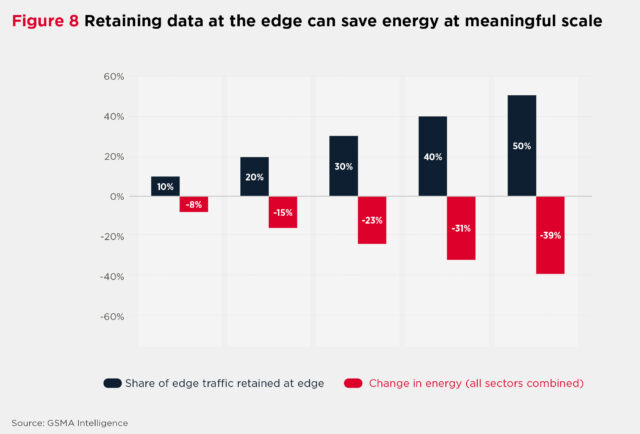In our previous blog, we focused on where the sustainability puck is, our overall research and where we are going in helping our telecom and enterprise customers reach their sustainability goals. Where does the puck go next? Out to the edge! What is interesting about the edge is that, as we make an impact in edge sustainability, I see the ROI for both communications service providers (CSPs) and the enterprise, making implementing these solutions even more compelling.
5G has been called “the Enterprise G” because CSPs have the potential to monetize their network investments as they work to solve enterprise challenges, leveraging their highly distributed network to process data where it is generated—at the edge and at customer sites. And if CSPs can build edge solutions with sustainability in mind, their ROI will be potentially better due to reductions in energy consumption. In our research with GSMA Intelligence, we found that by retaining 20% of traffic at the edge (instead of sending it to the cloud), there is a potential overall reduction in energy use of 15%. Similarly, at a higher scale, if 40% of edge data were retained, this would translate into an energy savings of just over 30% (see Figure 8 below). There are, of course, variations on this, but the edge can be more efficient if CSPs make better use of it in building enterprise solutions.
Sustainability at the Edge
When we think about moving workloads to the edge, we also need to consider the environmental requirements the hardware solutions will need to support. Edge environments require compute solutions that are ruggedized to handle harsh environments such as extreme heat and cold, high humidity, etc. For example, think about a CSP deployment of a private wireless solution in a manufacturing facility. The CSP would bring the hardware directly to the manufacturing customer and deploy it on-site, needing to ensure it can handle environmental conditions not typical of a traditional data center without the need for constant monitoring or replacement.
Flexible and independent sled configurations for servers are key to allow for deploying virtually any workload to the edge. Ensuring your hardware has ease of upgrading makes it possible to ride the wave of new technology, improving performance and lowering TCO.
In addition to being edge-ready and flexible, this equipment also needs to be efficient. Enterprise customers are deploying edge solutions to save themselves time and money. By not using a lot of power (people or energy) to maintain their equipment, the ROI is even greater—making the sales more compelling for CSPs.
AI, Management and Edge Compute
AI inferencing is increasingly being done at the edge, hence the term “EdgeAI.” This has opened up new opportunities for edge use cases that were previously unimaginable, building solutions like self-driving cars and video surveillance. As we capture more and more data at the source (the edge), it is important that CSPs have an energy-efficient approach as they deploy AI-enabled edge infrastructure. This will help minimize latency and enable real-time decision-making, which is crucial for many applications.
In addition to bringing AI to the edge, CSPs must be able to deploy and manage their (now) distributed hardware wherever it is outside of a data center. Dell NativeEdge helps enterprises securely scale their edge operations using automation, open design, Zero Trust security principles and multicloud connectivity. This means edge use cases across various industries can now securely power any workload, anywhere, to achieve desired business outcomes.
Today, more sustainable edge hardware like the PowerEdge XR8000 is a must, and the research with the GSMAi underscores the significance of an energy “dividend” by leveraging efficient processing at the edge. As industries across the board increasingly adopt edge computing, they not only enhance their operational efficiency but also contribute to sustainability efforts. The potential energy savings are not just theoretical; they translate into real-world impact, reducing the carbon footprint of digital operations in key industries.
As we look to the future, embracing edge computing in tandem with responsible practices and innovations is not just a choice, it’s an imperative. At Dell Technologies, we are excited about the future of sustainability at the edge and are well-positioned to drive these changes, paving the way for a more sustainable and efficient digital landscape. Learn more on how to push the edge to net zero.



